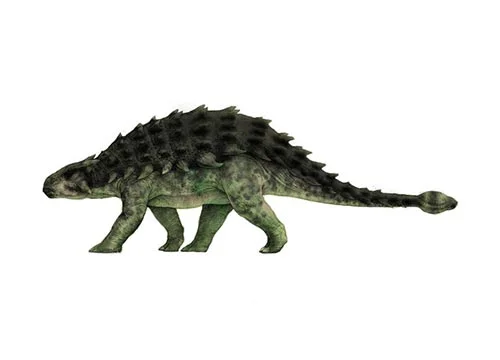Ankylosaurus (Fused lizard)

An-kie-lo-sore-us
Barnum Brown - 1908
Herbivore
Estimated 6-7 meters long
Armoured Dinosaur
A. magniventris (type)
Alberta – Horseshoe Canyon Formation, Scollard Formation. USA, Montana – Hell Creek Formation, New Mexico – Kirtland Formation, Wyoming – Ferris Formation, Lance Formation
Late Cretaceous, 74-67 million years ago
Ankylosaurus Facts
Ankylosaurus is a genus of armored dinosaurs found in fossilized geological structures dating back to the end of the Cretaceous Period, about 68-66 million years ago in the western part of North America.
It is the most well-known ankylosaurid, estimated to have measured between 6 to 8 metres (20 and 26 feet) in length and to weigh approximately 4.8 to 8 tonnes. It was quadrupedal with large, sturdy bodies and a large low skull with two horns that pointed backwards from the rear of the head.
Its nostrils were oriented sideways and its jaws were covered with armor plates or osteoderms. Ankylosaurus is part of the family Ankylosauridae, and is believed to have been a slow moving, non-selective hunter.
It is found in areas such as the Hell Creek, Lance, Scollard, Frenchman, and Ferris formations, and was associated with dinosaurs like Tyrannosaurus, Triceratops, and Edmontosaurus. In 1906, an American Museum of Natural History group discovered the original sample from Ankylosaurus magniventris, which consisted of the upper portion of the skull with two teeth, the upper part of the shoulder’s shoulder girdle cervical, dorsal, as well as caudal vertebrae, ribs and more than 30 osteoderms.
The name of the genus originates from the Greek words agkulos ankulos (‘bent or crooked’), referring to the medical term ankylosis which describes the stiffness caused by an fusion between bones inside the body and skull. Brown’s 1908 report included a skeletal reconstruction of Ankylosaurus that was similar to Glyptodon. Contrary to modern portrayals, it had strong forelimbs, a well-arched rear, and a pelvis that had prongs that protruded forwards from the pubis and ilium.
Brown’s reconstruction gained a lot of attention and restorations of the animal were published in the 1980s. Samuel Wendell Williston criticised the reconstruction, claiming it was an alias for the genus Stegopelta. Recent examinations have revealed that Brown had compared them to Euoplocephalus osteoderms. In 1910, an AMNH expedition located the remains of an Ankylosaurus species (AMNH 5214) within the Scollard Formation by the Red Deer River in Alberta, Canada. In 1947, American fossil hunters Charles M. Sternberg and T.
Potter Chamney collected the skull and mandible (specimen CMN 8880). In the 1960s, a caudal vertebrae section (specimen CCM V03) was discovered in the Powder River drainage, Montana. In 1990, American paleontologist Walter P. Coombs pointed out that two of the skulls’ teeth that were assigned to A. magniventris varied from the holotype specimen in a few particulars. Coombs also suggested that the teeth found in the sample of the holocene weren’t part of the species because they were discovered in a matrix inside these nasal chambers.



